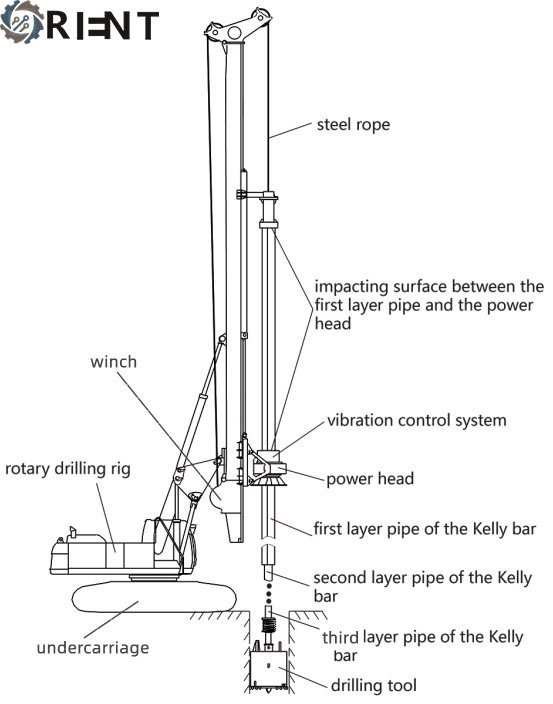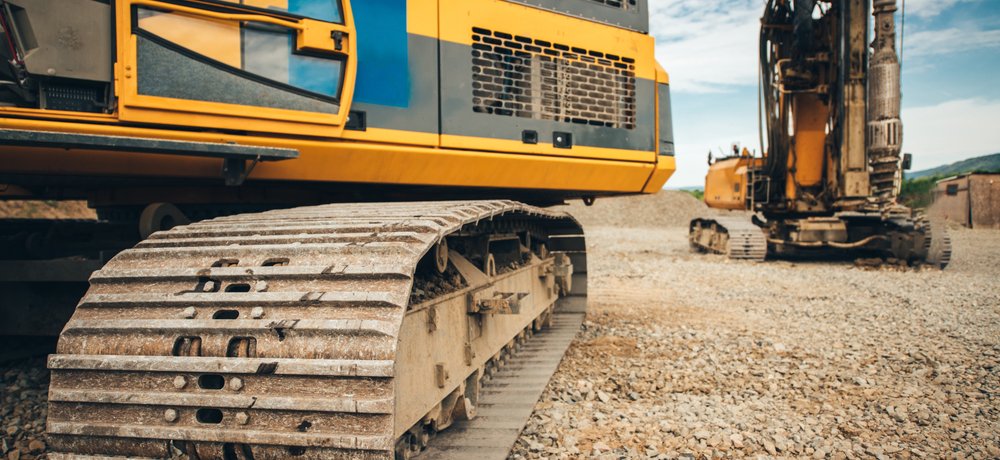2.jpg)
Main Structure and Function of Rotary Drilling Rig
Rotary drilling rig is a kind of construction machinery for soil borrowing and bored pile, which is widely used.
What do you know about rotary drilling rigs that have been used for so long? What are its main components? You know what?

Main Structure and Function of Rotary Drilling Rig:
The internal friction Kelly bar has high drilling efficiency in soft soil layer.
The locking type Kelly bar improves the downforce applied by the power head to the Kelly bar and transmitted to the drilling tool. It is suitable for drilling hard rock strata and has high requirements for operation.
In order to improve the operating efficiency, most of the drills are equipped with two sets of Kelly bars.

The power head has hydraulic transmission, motor transmission, and engine transmission. No matter what, it has the functions of low-speed drilling, reverse high-speed soil throwing. At present, most of them are driven by hydraulic pressure. The drilling speed of power head generally has multiple gears, which is suitable for operation under various working conditions.
The main winch is used to lift and lower the Kelly bar. It is composed of hydraulic motor, planetary reducer, brake, drum and wire rope. The main winch is closely related to the drilling efficiency, the probability of drilling accidents and the length of wire rope life.
The secondary winch is used for auxiliary work.
There are two types of pressurization: cylinder pressurization and winch pressurization.
Cylinder pressurization: the pressurizing cylinder is fixed on the mast, and the piston of the pressurizing cylinder is connected to the carriage of the power head.
Advantages: simple structure, convenient maintenance.
Winch pressurization: a winch assembly is installed on the mast, and two wire ropes are wound on the drum, one for pressurization and the other for lifting. The fixed pulley on the mast is connected with the movable pulley of the power head, and then fixed on the lower mast and the upper mast respectively to achieve lifting or pressurization conditions.
Advantages: greater pressurization can be achieved through movable pulley. Long spiral construction method can be realized.
Disadvantages: complex structure, troublesome assembly and disassembly, and additional precautions during operation.
Both the pressurizing cylinder and the winch pressurizing are to realize the pressurizing condition, but the pressurizing form is different.
Track Roller plays a supporting role and is located between the underframe beam and the track. Usually, there are 5-10 on one side.
Carrier Roller is used to support the track. Usually there are 1-2 on one side.
Idler plays the role of guiding the track and is located at the end opposite to the driving force. Generally, there are 2 for each rotary drilling rig.
Sprocket is fixed on the traveling motor and transmits the driving force of the traveling motor to the track through the gear structure. Usually there is one on each travel motor.
TracK Shoe Assembly consists of track chain and track shoes, The track assembly directly contacts with the ground and enables the rotary drilling rig to walk on the ground by transmitting power.

What do you know about rotary drilling rigs that have been used for so long? What are its main components? You know what?

Main Structure and Function of Rotary Drilling Rig:
1. Kelly Bar/ Drill Pipe
Kelly bar is a key component, which can be divided into internal friction type and automatic locking type.The internal friction Kelly bar has high drilling efficiency in soft soil layer.
The locking type Kelly bar improves the downforce applied by the power head to the Kelly bar and transmitted to the drilling tool. It is suitable for drilling hard rock strata and has high requirements for operation.
In order to improve the operating efficiency, most of the drills are equipped with two sets of Kelly bars.

2. Power Head
The power head is an important part of the rotary drilling rig, which is used to output torque and is composed of variable hydraulic motor, planetary reducer, power box and some auxiliary parts.The power head has hydraulic transmission, motor transmission, and engine transmission. No matter what, it has the functions of low-speed drilling, reverse high-speed soil throwing. At present, most of them are driven by hydraulic pressure. The drilling speed of power head generally has multiple gears, which is suitable for operation under various working conditions.
3. Winch
As an important part of rotary drilling rig, winch includes main winch and secondary winch.The main winch is used to lift and lower the Kelly bar. It is composed of hydraulic motor, planetary reducer, brake, drum and wire rope. The main winch is closely related to the drilling efficiency, the probability of drilling accidents and the length of wire rope life.
The secondary winch is used for auxiliary work.
4. Pressurizing Device
Function: apply pressure to the power head, and the pressure is transmitted by the pressurizing device → power head → drill pipe → drill bit → tooth tip, to achieve the purpose of cutting, crushing or grinding.There are two types of pressurization: cylinder pressurization and winch pressurization.
Cylinder pressurization: the pressurizing cylinder is fixed on the mast, and the piston of the pressurizing cylinder is connected to the carriage of the power head.
Advantages: simple structure, convenient maintenance.
Winch pressurization: a winch assembly is installed on the mast, and two wire ropes are wound on the drum, one for pressurization and the other for lifting. The fixed pulley on the mast is connected with the movable pulley of the power head, and then fixed on the lower mast and the upper mast respectively to achieve lifting or pressurization conditions.
Advantages: greater pressurization can be achieved through movable pulley. Long spiral construction method can be realized.
Disadvantages: complex structure, troublesome assembly and disassembly, and additional precautions during operation.
Both the pressurizing cylinder and the winch pressurizing are to realize the pressurizing condition, but the pressurizing form is different.
5. Undercarriage
Rotary drilling rig undercarriage accessories mainly include: track roller, carrier roller, idler, sprocket and track shoe assembly.Track Roller plays a supporting role and is located between the underframe beam and the track. Usually, there are 5-10 on one side.
Carrier Roller is used to support the track. Usually there are 1-2 on one side.
Idler plays the role of guiding the track and is located at the end opposite to the driving force. Generally, there are 2 for each rotary drilling rig.
Sprocket is fixed on the traveling motor and transmits the driving force of the traveling motor to the track through the gear structure. Usually there is one on each travel motor.
TracK Shoe Assembly consists of track chain and track shoes, The track assembly directly contacts with the ground and enables the rotary drilling rig to walk on the ground by transmitting power.



2.png)
3.jpg)

2.jpg)

Leave a comment